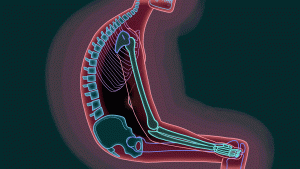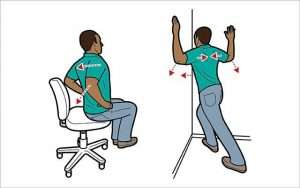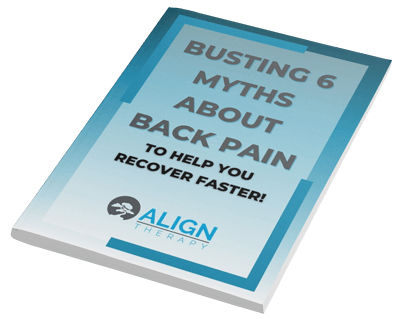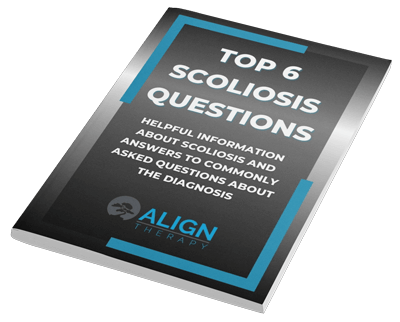What is meant by good or bad posture?
It is very common for Physical Therapists to get a lot of questions about posture. When most people think of posture, they think it means to sit up straight or not to slouch. But what is posture really? Posture simply refers to the position of your body either in a standing or sitting position. If I were sitting comfortably on the couch (like I am while writing this), then I would be in a sitting posture. Inherently, posture does not mean the position is bad or good. It is just an alignment of the body at that particular time.
So, if posture is any position I am sitting or standing in, then what do people mean by good or bad posture? In physical therapy, when we talk about good posture, we are referring to a balanced position of the body where the tissues are all working together to maintain that position against gravity.
In “good posture”, the forces acting on the body are distributed evenly so that the weight of the body is not being maintained by a few muscles, but by many. Because so many muscles are involved in maintaining that position, it is much easier and more efficient for the body to maintain.
Now, let’s say that you take that body out of that balanced position by bending forward to look at your phone or laptop screen, what would happen in this no-longer balanced position? Well, one thing that would happen is the muscles that hold your head would have to work extra hard to keep the head in that position.
On top of that, let’s imagine that you spend a lot of time in this position (like many of us do), what would happen then? Well, those muscles which are already working extra hard, would start to get fatigued and tighten up, maybe even start to hurt. This or any imbalanced position would be referred to as bad posture.
Still have a few questions about posture? Not to worry, here are some answers to five common questions about posture.
1.How do I know if I have good or bad posture?
This is an excellent question! Think about how you sit during the day. Is your head forward or over your body? Are your shoulders and spine rounded forward, or back and straight? Are your feet flat on the floor under your knees or out in front of you? Not sure? That’s okay! It can be hard to notice the positioning of your body throughout the day. Lets try answering another question. After sitting or standing for a while, do you start to have aches and pains in your back, neck, or shoulders? If you said yes, then it could be posture related.
As physical therapists,we assess posture by looking for any imbalance in the position of the body. Some things we watch out for are a forward head posture, rounded shoulders or excessive curvature in the spine, but these things can be hard to look out for yourself. A better way to assess your posture is by symptoms like aches and pains. If you find that sitting or standing is uncomfortable and you have to adjust positions frequently, you may want to consider having your posture assessed by a professional.

2. My back aches when I sit for a long time, does that mean I have bad posture?
It depends! Back aches can be an indicator of bad posture, but not always. Back aches or back pain can be caused by many things and is unfortunately very common. In fact, if you want to read a post specifically about back pain click here (https://aligntherapyutah.com/why-is-back-pain-sooo-common/). Bad posture itself can be contributing factor to many issues, from headaches to back pain, and even breathing problems in extreme cases.
To determine what is causing your back ache, several factors would need to be assessed. What type of chair are you sitting in and how supportive is it? How strong are your stabilizing muscles and are they properly supporting you? What position are you sitting in? Are there any other contributing factors to your backache. Etc.. As you can see, this can be a complex question to answer.

3. Can I improve my posture?
Absolutely! Posture can be improved with a combination of strengthening weakened muscles and stretching tight muscles. The trick is knowing which muscles to focus on. For strengthening, exercises that generally have a pulling motion, like rows, can be very helpful in bringing the shoulders back to improve posture. Pulling exercises tend to focus on back muscles which tend to be weak in people with bad posture.
Weak back muscles in combination with tight front muscles lend toward a more forward rounded shoulder posture. Pro tip: Do a back exercise every other day to maintain strong postural muscles. For stretching, make sure you are opening up the chest by stretching the arms back like in a corner or doorway stretch.
These stretches will help to release the tension in the front of the body to allow the shoulders to come back into a better posture. Pro tip #2: Stretch can be done twice a day help to improve posture.
4. Do I have to keep my back straight all the time to have good posture?
No! No one has perfect posture all day. The trick is to practice sitting in a good, comfortable position throughout the day. Pro tip #3: Set an alarm on your phone or computer to remind you to practice good sitting posture every hour. For five minutes at a time, try to maintain that position.
It is natural for you to slowly go back into your default posture because that position is more familiar to your body. But, by practicing a good posture throughout the day, you are creating a new default for your body. You slowly become better at maintaining that new position for a longer period of time, as you will strengthen those postural muscles.

5. Why does it matter if I have bad posture?
Posture plays a big rule! Bad posture over time can cause an imbalance of the muscles that maintain your body in an upright position. As overworked muscles become tighter and underutilized muscles become weaker, the body begins to make adaptations to normal movement that can make you more prone to injury, increase headache frequency, reduce mobility, increase pain and so on.
Why take the risk? While you may not be noticing any aches or pains now, bad posture in likely to become a problem down the road, so let’s take the opportunity to nip it in the bud!

What can we do to help you and your posture?
Everyone’s posture is different but I hope this post has answered some of the questions that you had. Still have more questions? We would love to hear from you! Posture can be a complicated topic but we are here to help.
Feel free to comment or come into our office for a FREE consultation where we can answer more specific questions that you have. You can also email at david@aligntherapyutah.com or call at 801.980.0860!

Gina deCesare, Student Physical Therapist
Align Therapy




